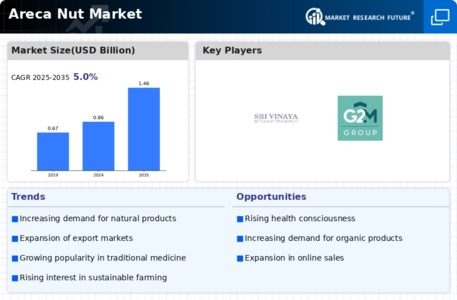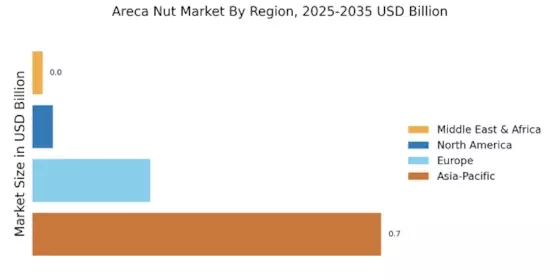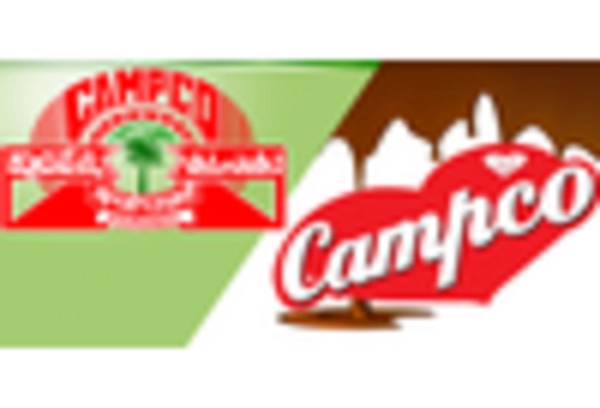Expansion of Export Markets
The Areca Nut Market is witnessing a significant expansion in export markets, particularly in regions where areca nuts are not traditionally cultivated. Countries such as the United States and various European nations are increasingly importing areca nuts for use in specialty products and cultural practices. In 2025, the export value of areca nuts is estimated to exceed 300 million USD, indicating a robust growth trajectory. This trend is likely influenced by the growing interest in exotic and traditional products among consumers in these markets. Additionally, the establishment of trade agreements and favorable tariffs may further enhance the competitiveness of areca nut exports. As a result, the Areca Nut Market is expected to benefit from increased international trade, leading to greater market penetration and brand recognition on a global scale.
Growing Awareness of Health Benefits
The Areca Nut Market is benefiting from a growing awareness of the health benefits associated with areca nuts. Research suggests that areca nuts may possess certain health-promoting properties, including potential antioxidant and anti-inflammatory effects. As consumers become more health-conscious, there is an increasing interest in natural products that offer perceived health advantages. In 2025, the market for health-oriented areca nut products is expected to grow by approximately 15%, driven by this trend. Additionally, the rise of herbal and traditional remedies is likely to further bolster the demand for areca nuts in various forms, such as supplements and herbal teas. This shift towards health-focused consumption patterns presents a significant opportunity for the Areca Nut Market to innovate and diversify its product offerings.
Rising Demand for Areca Nut Products
The Areca Nut Market is experiencing a notable increase in demand for areca nut products, particularly in regions where traditional practices are prevalent. This surge is attributed to the cultural significance of areca nuts in various ceremonies and social gatherings. In 2025, the consumption of areca nuts is projected to reach approximately 1.5 million tons, reflecting a compound annual growth rate of around 5%. This growth is likely driven by the increasing popularity of areca nut-based products, such as betel quid, which is widely consumed in many Asian countries. The rising awareness of the health benefits associated with areca nuts, including their potential antioxidant properties, further fuels this demand. As a result, the Areca Nut Market is poised for expansion, with manufacturers exploring innovative product offerings to cater to evolving consumer preferences.
Technological Advancements in Cultivation
Technological advancements in cultivation practices are playing a pivotal role in shaping the Areca Nut Market. Innovations such as precision agriculture and improved irrigation techniques are enhancing yield and quality, thereby meeting the rising demand for areca nuts. In 2025, it is anticipated that the average yield per hectare will increase by approximately 10% due to these advancements. Furthermore, the adoption of sustainable farming practices is likely to resonate with environmentally conscious consumers, potentially boosting market appeal. The integration of technology in the cultivation process not only improves efficiency but also reduces production costs, making areca nut farming more viable for smallholder farmers. Consequently, the Areca Nut Market stands to gain from these developments, as they contribute to a more sustainable and productive supply chain.
Cultural Significance and Traditional Practices
The cultural significance of areca nuts in various societies is a key driver for the Areca Nut Market. In many Asian cultures, areca nuts are integral to social rituals, ceremonies, and traditional practices, which sustains their demand. The continued use of areca nuts in betel quid, a popular chew, underscores their importance in social interactions. In 2025, it is estimated that the consumption of areca nuts for traditional practices will account for over 60% of the total market share. This enduring cultural relevance not only supports consistent demand but also encourages the preservation of traditional cultivation methods. As a result, the Areca Nut Market is likely to thrive, as it aligns with consumer preferences for products that embody cultural heritage and authenticity.


















Leave a Comment